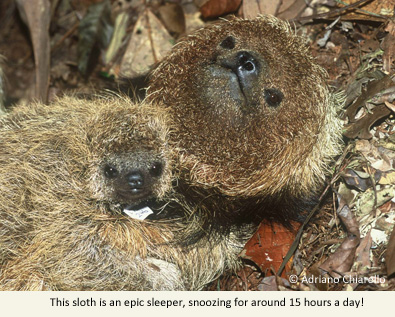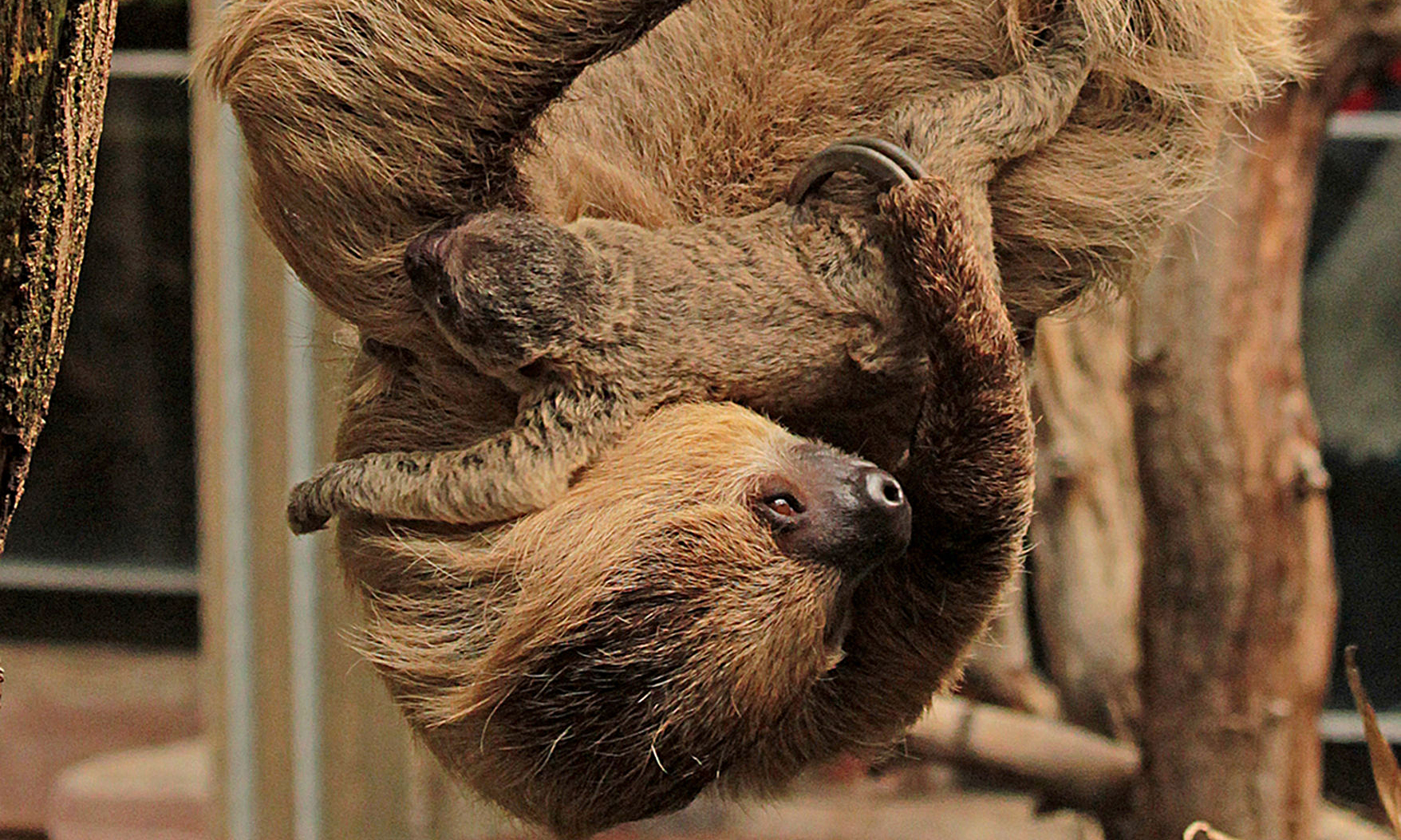How Sloths Breed
Posted : admin On 3/26/2022The documentary takes viewers to a sloth sanctuary in Costa Rica, run by a “sloth whisperer” Judy Arroyo. The sanctuary is home to some 160 sloths, many of them orphaned or injured.
Costa Rica is home to two species of sloth, the brown-throated three-toed sloth and Hoffmann’s two-toed sloth. Black eye patches and “smiling” mouths distinguish Costa Rica’s docile three-toed sloths, while the larger two-toed variety have white-ringed faces, brown snouts and shaggy coats. Sloths are especially unique in that they spend nearly their entire lives hanging upside down in. The sloth’s main source of nutrition is leaves, twigs, and fruit. This diet leaves a sloth with very little energy to move around, low metabolism, and low body temperature. Sloths have a four-part stomach that slowly digests the tough leaves they eat. It can sometimes take up to a month for a sloth to digest a meal.
Sloths
Hilights
- Scientific Name: Bradypus variegatus and Choleopus hoffmanni
- Status in the Wild: Common
- Habitat:Cloud Forests, Rainforests
- Diet: Omnivore

Costa Rica is home to two species of sloth, the brown-throated three-toed sloth and Hoffmann’s two-toed sloth. Black eye patches and “smiling” mouths distinguish Costa Rica’s docile three-toed sloths, while the larger two-toed variety have white-ringed faces, brown snouts and shaggy coats. Sloths are especially unique in that they spend nearly their entire lives hanging upside down in a tree; they sleep, eat, mate and even give birth upside down!

What do female sloths do when they are ready to breed? Let out a scream to alert interested males. How does the mother influence the baby's diet? Three-toed sloths do not survive outside of their natural habitat, so you will only see two-toed sloths available that are captive-bred; specifically the Linnaeus' two-toed sloth. A good portion of the information provided here comes from the Sloth Captive Husbandry Research Center, which is one of the few facilities focusing on the captive.
read moreclose$dotcontent.find('7ca42581-b81d-4eb2-8520-3f13e7c76947').customCodeNot surprisingly, both species are highly adapted to living in the treetops; their long claws provide a tenacious grip to the slightest of branches. Sloths sleep an average of fourteen to eighteen hours per day, so it is most common to see them as furry balls tucked into the crooks of tree branches. Their long guard hairs encourage algae growth, which helps them camouflage in the forest canopy. The average lifespan of a wild sloth is 10-16 years, though they can live into their mid-thirties in captivity.
The genus names of both sloth species refer to the animals’ slow locomotion: in the case of the three-toed sloth, Bradypus means “slowness of foot,” while two-toed sloths are Choleopus, or “lameness of foot.” Likewise, their common names in Spanish (perezoso) and English refer to their sluggish nature. However, sloths are not so much lazy as they are at the mercy of their incredibly slow digestive tracts. While most herbivores process food in mere hours, it can take more than four weeks for a sloth to digest one leaf. Therefore, energy is at a premium, and sloths exercise conservation of movement. Despite their lethargic movement on land, sloths are surprisingly agile swimmers, and have been observed using a modified overhand stroke.
Three-toed sloths are active both day and night, while the Hoffman’s sloth is mostly nocturnal. Both species live in the forest canopy, usually in dense tree crowns, where they can be difficult to spot due to their greenish-gray fur and relative stillness. In Costa Rica, sloths often feed on the leaves of cecropia trees, which are less dense and therefore a favorite place for nature hikers to sloth-watch. The two-toed sloth is primarily herbivorous, but occasionally supplements its diet with lizards, bird eggs and insects.
Both species have the peculiar habit of relieving themselves on the forest floor just once a week. They do not urinate or defecate in between these sessions, and can therefore expel as much as 1/3 of their entire body weight during this time. Scientists have not yet discovered the reason for this behavior. However, it is known that once a sloth relieves itself at the base of a tree, it will not return, choosing instead another tree in the area.
Habitat:

Brown-throated sloths are found from Honduras south through northern Argentina. These three-toed sloths inhabit primary and secondary forest between sea level and 7,900 feet, although they sometimes live in large parks. The range of Hoffman’s sloths stretches from Honduras down to Bolivia. They are found between sea level and 11,000 feet, and stick to primary and secondary forests.

In Costa Rica, both types are found throughout the country, except at very high elevations. In wet, lowland forests, three-toed sloths are more common than Hoffman’s two-toed, often outnumbering the latter 4 to 1. Both can be spotted in the forests of Tortuguero, Puerto Viejo, Manuel Antonio, and the Osa Peninsula, as well as throughout much of the Central Valley. The Sloth Rescue Center in Cahuita is currently the only sloth sanctuary in the world, and is an excellent choice for personal encounters with these unique mammals.
Reproduction:
Brown-throated three-toed sloths have a gestational period of six months, after which females give birth to just one baby. When her offspring reaches two weeks in age, a mother three-toed sloth begins feeding it small leaf fragments from her lips.
Three-toed young spend the first four months of life attached to their mothers, and they will feed on whatever she does. When a juvenile reaches approximately six months in age, the mother will abandon it and leave for another area within her range. At this time, the youth begins to fend for itself, but will retain its mother’s food preferences.

Hoffman’s two-toed sloths have almost twice the gestational period of their three-toed cousins – 11.5 months. Females give birth to a single baby that nurses for the first month. Two-toed babies attach to their mothers for the first five months of life, after which time they may follow their mothers for up to two years.
Females reach sexual maturity at around two years of age, whereas males mature one to two years later. Scientists have observed that females outnumber males in the wild, and propose that this gender imbalance may account for the long gestational period. This may also help increase reproduction, as sloths do not mate often, and few males are necessary to perpetuate the species.
How Many Sloth Breeds Are There
Status in the Wild:
Two and three-toed sloths are some of Costa Rica’s most common mammals, and neither species is threatened. Some experts suggest that as the sloths’ native habitat has been cut down, the animals have actually flourished due to elimination and/or relocation of large predators such as jaguars, ocelots, snakes and harpy eagles.
Sloths in Pictures
How Sloths Mate
- sloths on cecropia tree manuel antonio - Costa Rica'>
- sloth with baby sloth puerto viejo limon - Costa Rica'>
- baby two toed sloth rescue center - Costa Rica'>